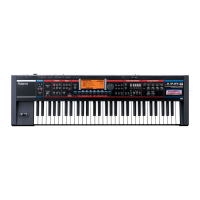6
To select sounds from the CATEGORY list:
On the PATCH PLAY screen, press the ENTER•LIST button to
1
display the CATEGORY List screen.
Use F1 (Up) and F2 (Down) to choose categories, and turn the Value 2
dial or use DEC/INC to select the desired sound.
To switch between patch and rhythm set lists, press F5 (Patch) or F6
3
(RHYTHM).
To confirm your final selection, press ENTER.
4
To learn how to register sounds as Favorite sounds, see Page 28 of the
JUNO-G Owner’s Manual.
Playing Patches and Rhythm Sets
After using one of the above methods for selecting a sound—a patch or a
rhythm set—try playing the sound on the keyboard. If you selected a
patch—
• you can play the sound up and down the keyboard.
rhythm set—
• note how each key on the keyboard plays a different
sound.
Getting Real with Realtime Control
The JUNO-G’s sounds aren’t simply there—they respond musically to how
you play them, and you can also change them as you play them using a
variety of “realtime” controls.
For the next section, select a patch to explore the things we’ll discuss.
The Responsive JUNO-G Keyboard
As far as the sound’s responsiveness goes: The JUNO-G’s keyboard detects the
force, or “velocity,” with which you play, and sounds change accordingly.
Low velocity High velocity
Getting louder and/or brighter as you play harder is one of the most
common velocity responses, though, really, lots of things can change with
your playing force.
Try playing the patch you’ve selected and see how it responds sonically to
your touch.
If you find you have to play uncomfortably hard or unnaturally soft
to make the sounds react, you can change the keyboard’s touch
sensitivity, as described on Page 159 of the Owner’s Manual.
The Pitch Bend/Modulation Lever
The most basic way to control a patch’s sound in realtime is by using the
Pitch Bend/Modulation lever to the left of the keyboard. Flip the lever
left or right to lower or raise the pitch of notes, or push it forward to add
modulation to the notes. Modulation—which simply means “change”—is
most often vibrato, but can be most anything, depending on how the patch
is programmed.
Bend note pitches Push to add modulation,
release to remove it

